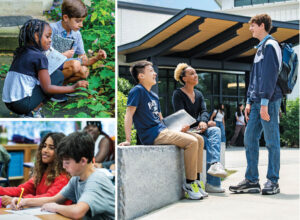I ask my students to do ridiculous things. Often.
In September, I usually plan a unit that will set the tone for the year, take the class out of their comfort zones and introduce vocabulary and concepts that I plan to return to again and again as we move forward in our work. In past years we’ve started with improvisation, with devised movement, with mask work and with storytelling. This year we started with clown.
The day I gave them their red noses we created a ritual together. We formed a circle, took a breath and made eye contact with each other. We dropped our heads and donned our noses. Then our clowns looked up and made eye contact again – and the mere addition of these noses allowed for some essential transformation, or revelation, of authentic truth. The nose gives permission by both hiding and revealing at the same time.
And then we moved on to the ridiculous: eccentric dancing, the composing of songs with titles like “Do I Have To?” and “When the Pizza Arrives,” and Sports Illustrated photo shoots of their clowns’ athletic achievements. Somehow the kids trust that I’m going somewhere with all this. I am: if I’ve played my cards right, all this risky play will lay the foundation for the riskier work to come in our next unit, and the one after that.
Made possible by a Summer Fellowship grant funded by The Fund for AFS, I spent two weeks this summer at Lincoln Center’s Leadership Lab in Teaching Artistry. It was an immersive experience, spent in a cohort of 22 peer artists from varied disciplines: music, visual arts and theatre. We were all there to accomplish some very specific tasks: to clarify our individual teaching and leadership philosophies, and to identify and assess how we wanted to improve and expand those practices. How to do this? Through clowning, we discovered.
We found that clowns are not undone by dilemma. Their intuitive response to challenge is “No problem!” Their brains are rather soft, and they tend to process slooooowwly. They do not erase themselves to do something perfectly. They enjoy being present, and they live with pleasure. Together, we examined our work as teachers and leaders through the lens of the clown, using the metaphor as a way to see goals, to make adjustments, to check in with our audiences, to delight in imperfection.
One of the central concepts our facilitator, Eric Booth, introduced was the idea of “our circles” those people we carry with us as we go on to do the work that connects us to each other. My colleagues at Lincoln Center were from all corners of the world: Australia, Peru, Canada, Mexico City, Los Angeles, Memphis, Buffalo and Chicago, among others; and I now include each of them in my circle. I thought a lot about others I carry in that circle with me: the teachers I’ve studied with, the artist-friends I’ve learned with, and the former students who continue to teach me.
I’m grateful for the circle of former AFS colleagues that have helped cultivate me as a teacher—Rita Burroughs, Mary Carpenter, Christopher Buzby and Deb Pizzi. And when I look around the circle of mischievous, hopeful clowns in my classroom this fall, I am doubly grateful for the opportunity to pay that teaching forward: to learn together how to be present, how to live joyfully, and how to face obstacles with courage. “No problem!”


